Main Menu
Latest Blog Entry
User login
3 pillars of athletic development: Kelvin Giles
Great coaches find a way or make one”
Kelvin Giles presenting his “Quest for physical literacy” in Exeter on Monday.
The theme was putting precision, variety, and progression into the coaching and teaching of young people at every opportunity.
Kelvin gave a great one-day workshop which had coaches, parents, teachers, physiotherapists, and also 4 junior international athletes attending.
The 3 pillars of athletic development
Kelvin outlined his take on this:
- Cardiorespiratory (metabolic) efficiency: the running, swimming, and cycling that gets the heart and lungs working.
- Nutritional quality: what the athletes put into their mouths and bodies.
- Mechanical (movement) efficiency: the focus of the day.
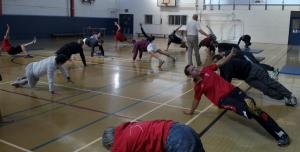 When looking at mechanical efficiency, the load must be determined by the quality of the technique.
When looking at mechanical efficiency, the load must be determined by the quality of the technique.
That load is either: speed, distance, volume, direction, complexity, or the surface upon which it is performed.
When all of this is perfect, only then can you progress. “Function before sports specific skill, force, speed or endurance.“
This is criterion-based progression: the athlete must earn the physical right to progress. The adaptation must be permanent and consistent.
(Compare that with the norm which is “no weights until you are 16, now we start with power cleans”, or “you can’t do a bodyweight squat? Never mind, get in the smith machine and we can add some weight because you are too skinny” James’ rant over).
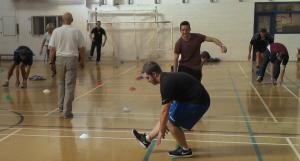 Kelvin gave examples of this, and we started with a lot of squat variations, followed by physical competency assessments.
Kelvin gave examples of this, and we started with a lot of squat variations, followed by physical competency assessments.
I have done this 4 times previously with Kelvin, but always learn something new. Today it was that spending 4 hours in a car leads to tight hamstrings!
The state of the nation
Kelvin spent a good portion of the day outlining the data and research behind our lack of physical ability.
As a coach of young people, or even senior clubs and teams, it is easy to concentrate on “performance outcomes” either in the gym or in the win/ loss column. However, it is important to remember where these athletes are coming from.
It is alright to have “medal targets” for the Rio and Tokyo Olympics, but the simple fact is that we have a young generation of unfit, overweight kids who struggle to move properly. Kelvin laid this out very well.
It is everyone’s responsibility to help solve this problem. The answer isn’t with PE “specialists” being put into primary schools, chucking a ball at 30 kids, and saying, “Play a game.”
The answer isn’t with hordes of sports science students being able to recite force/ time relationships or measuring Vo2 max on a treadmill but unable to coach a press up or a squat properly. Let alone sequence those movements into a meaningful, engaging coaching session.
The answer lies with better coaching and teaching: “If you don’t chase precision, you are supporting mediocrity”.
“Kids aren’t afraid of hard work, they’re afraid of boredom”. Wayne Goldsmith
“My butt is killing me”
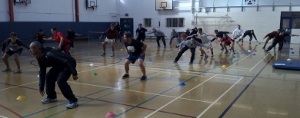 The last hour of the day was all practical with Kelvin taking the group through some lunge progressions, sway drill variations and single-leg squat variants.
The last hour of the day was all practical with Kelvin taking the group through some lunge progressions, sway drill variations and single-leg squat variants.
“Are we teaching/ coaching them to discover, or to be robotic?” Kelvin put all his theory and experience into practice.
This was a great example of how good coaching and using time and space can create overload, rather than justing adding weight. “The minute you put a bar on someone’s shoulders you slow them down“.
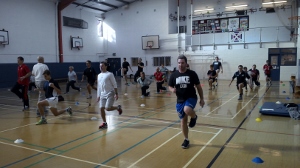 With minimal coaching cues, Kelvin set tasks that their bodies had to solve: linear, lateral, rotational, squatting, bracing, and hinging. So much variation and fun, with just the body.
With minimal coaching cues, Kelvin set tasks that their bodies had to solve: linear, lateral, rotational, squatting, bracing, and hinging. So much variation and fun, with just the body.
As Steve Myrland says “Complex equipment tends to yield simplistic results, simple equipment tends to yield complex results
Summary and the Way Ahead
Thanks to everyone who took part, and especially to Kelvin for once again delivering a great workshop (following on from his session at Willand School, I have been helping them further implement the ideas).
Contact me if you would like a similar course run near you
Client Testimonials
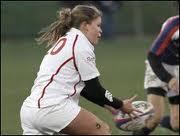 Georgina Rozario: England Scrum Half
Georgina Rozario: England Scrum Half
I had the pleasure of having James as my first s&c coach when I was at University in Plymouth. I worked with him for 3 years and learnt everything I now know about training to the best of my ability. When I first saw James I was identified as a talented rugby player but had various injury and illness problems to contend with. By the end of my time with him I had become an athlete and later received my first international cap against the U.S.A.
More


Comments
[…] Exeter School 3 Pillars of athletic development (pictured) […]
[…] planes, angles and speed whilst challenging balance and coordination. It is somethingI learnt from Kelvin Giles who reminded me recently that it is all too easy to do body weight squats for a few weeks then […]
[…] The 3 pillars of athletic development […]
[…] with my work with Paula Jardine and the South West Talent project, continued when I was Head of Athletic Development at Millfield School and has come to fruition […]